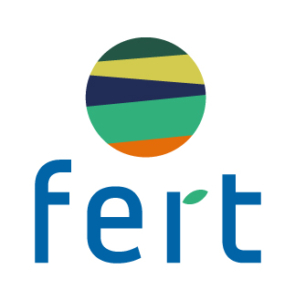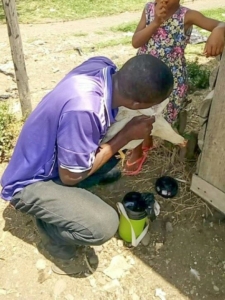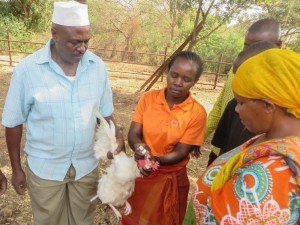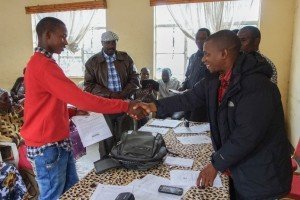Livestock keeping is an intergral part of family farming systems for a vast majority of farmers of Arusha and Kilimanjaro regions. On top of providing households with food diversity thanks to meat, eggs and milk productions, cattle, goats and chicken breedings are essential for farm viability: they generate regular incomes in addition to seasonal incomes from crop productions.
However, disease control remains a recurrent issue for livestock keepers. They impact strongly farms development and profitability. Even if the Government offers a public animal health service, the number of vet officers remains insufficient and are focused on large animals (cattle and goats), which don’t satisfy the demand. Thus, Fert organizes trainings of animal health auxiliaries, known as paravets, to offer a service adapted to small livestock keepers.
A mission focused on disease prevention
After the training of a first group of paravets in 2015, an evaluation of the service was conducted in mid 2017. The objective was to understand how paravets deliver their service to farmers in order to define better their mission and to organize the training of a second group of paravets in 2017.
It appears from the evaluation that:
- Paravets are active in the field: they dedicate 3 hours a day in average to this activity and intervene mainly on cows, goats, sheep and chicken;
- Mortality of chicken has significantly decrease and husbandry condition have been improved among beneficiaries of the service;
- The service is profitable: paravets generate a margin of 50% in average, after deducting drug and transport costs;
- More paravets keep a close relationship with Government vet officers, better is the service provided.
Based on these findings and in collaboration with Government animal health service representatives and group’s leaders, the paravet mission was refocused on technical advisory and disease prevention, and a selection process was conducted to identify 13 new paravets to train in 2017.
For this second session, training (financed by Fert) covered good husbandry practices in chicken, goats and cattle production (hygiene, housing, feeding), animal pest control, chicken vaccination and basic treatments (mainly on chicken, goats and sheep). It was conducted at Himo in October 2017 at Kilacha Training Center, institute recognized by the Government. Medical kits, composed of drugs and basic equipments, were distributed to paravets so they can start their new activity and to continue practical training in the field. Thus, field officers accompany paravets during interventions and advice them to set prices to ensure quality and sustainability of service provided.
Following the training, a meeting was organized in November 2017, in the presence of new paravets and Government vet officers in order to strengthen their collaboration. After receiving their license from Government animal health service representatives, paravets were linked to vet officers of their wards.
Promising first steps
After few months of activity, new paravets found their bearings. This is the case of Abdalah Kahanankila, working in Ngare Nanyuki ward, who mainly supports chicken breeders.
“I regularly organize common vaccinations of chicks to face high farmer demand. To this end, after assessing needs, we set a date to conduct vaccination. Then, I go to town to buy vaccines and I bring them back with my cool box.”
Abdalah takes to heart his mission. He is more and more sought by livestock keepers for his service, partly thanks to the relationship he is maintaining with the ward vet officer, who, aware of the needs, sees some good in the arrival of the paravet.
“When I face a case I don’t master, I contact the ward vet officer to share with him symptoms observed. As far as possible, he tells me what to do to meet farmer’s expectations. Also, the vet officer invites me punctually to follow him during his rounds, to train me on new interventions within my grasp.”





